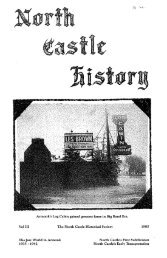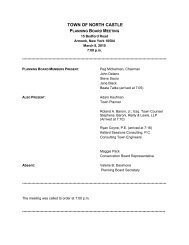NORTH CASTLE HISTORY - The Town of North Castle
NORTH CASTLE HISTORY - The Town of North Castle
NORTH CASTLE HISTORY - The Town of North Castle
You also want an ePaper? Increase the reach of your titles
YUMPU automatically turns print PDFs into web optimized ePapers that Google loves.
HISTORICAL DEVELOPMENT OF <strong>NORTH</strong> WHITE PLALNS<br />
Oral History by Joseph T. Miller<br />
(Pictures, descriptions and foohlotes have been added to enhance the details.)<br />
Hon. Joseph I: Miller presented the following Oral History at the Cl~mter Afeeting <strong>of</strong><br />
Tlre Nnrtlr <strong>Castle</strong> Historical Society held at the <strong>North</strong> <strong>Castle</strong> Library irr Arrnonk on<br />
Febrcmiy 29,1972. Mr. Miller Worked as Norflz <strong>Castle</strong> Toivrz Clerk for 35years. He also<br />
served as a Fire Cornnrissioner and a <strong>Town</strong> Cormcilmnn. His finnily "roved to No~flr<br />
<strong>Castle</strong> when he nvas hvo years old. He developed n keerr interest in his1or.y and<br />
contributed greatly fn orrr krmivledge. He was a charter inember and also served ns a<br />
Enslee <strong>of</strong> Tlre Sociefy. Joe died Uecernber 71, 1975, arrd the 1976przblicatios &&<br />
<strong>Castle</strong> iin tl~e Ainericaa Revohrlio,~ was deflicoted to his mernory. A Memorial Tn'br~te by<br />
Richard N. Lnrrder ayperrred in the 1976 issue <strong>of</strong> Nortli Cnslle Histor3<br />
In its early history the great swamps, called white marshes dm to tlie low<br />
white fog that hung over the area, and the rugged rocky bills, called the<br />
Hills <strong>of</strong> <strong>North</strong> <strong>Castle</strong>, made this area alnlost a fot-bidden if not an<br />
undesirable place for early settlers. Yet these hills and swamps were to<br />
become dranlatically historical.<br />
<strong>The</strong>se impassable swamps covered the following present areas: <strong>The</strong><br />
Kensico Dan1 Plaza, the railroad yards incl~lding Conklin-Pfister's lumber<br />
yard', both sides <strong>of</strong> the Bronx River and the <strong>North</strong> White Plaills Shopping<br />
Center, which, by the way is built on piles that go fro111 60 to 100 feet deep<br />
into swamp muck for foundation.<br />
<strong>The</strong>se swalnps have now allnost disappeared as a result <strong>of</strong> drainage and<br />
fill-in operations but not before they frustrated the 30,000 British and<br />
Hession soldiers from dislodging Washington's ragged army fi-0111 the<br />
hills <strong>of</strong> <strong>North</strong> <strong>Castle</strong>, especially fro111 Miller Hill and Mt. Miseryz, the two<br />
rugged hills that faced these swanips. <strong>The</strong> last shots <strong>of</strong> the Battle <strong>of</strong> White<br />
Plains were made from the cannons on Miller Hill against the British on<br />
Travis Hill located jnst west <strong>of</strong> and opposite the present <strong>North</strong> White<br />
Plains Railroad Station.<br />
- -.<br />
Adolf Pfisle~ & Sons rao a lumber company on Broadway next to Harmnond's Candy<br />
Store. <strong>The</strong> propel* afterwards was used for a luncheonette business. At the t111n <strong>of</strong> the<br />
cenhlry the Pfisters ran a grocery stare and the post <strong>of</strong>fice for old Kensico.<br />
'Bolton, Jr., Robert, A Historv <strong>of</strong> the Countv <strong>of</strong> Westchester, (New York, NY) 1848, page<br />
447, wrote that Mt. Miscry is so-nan~ed because a large body <strong>of</strong> Indians was s~rrprised and<br />
cut to pieces by the Huguenots in retaliation for a "descent upon New Rochelle".<br />
15









